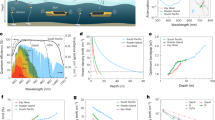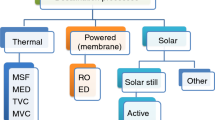Abstract
Solar photovoltaic (PV) modules submerged underwater can provide useful power to various types of electronic sensors and robotic vehicles, which may be used for scientific research and defense applications. In the present work, outdoor performance evaluation of a 50 W monocrystalline PV module submerged in water is presented. Experiments were conducted in the morning and noontime to study the effect of varying solar irradiance on module power output. At a depth of ~ 0.3 m underwater, the module provided 20.77 W of power, showing a power loss of about 35% in the noontime. Reduction in photocurrent was the dominant factor responsible for the observed power loss. Water also provided cooling to the PV module, and consequently no significant variation in open-circuit voltage was observed. Appreciable values of power were obtained for various water depths and varying solar irradiance values. Spectral response study showed that visible light (400–700 nm) is poorly absorbed, and the infra-red (700–1100 nm) region of the solar spectrum is significantly absorbed by water. Consequently, a substantial drop in photocurrent is observed even at shallow water depths of 5–10 cm. Si solar cells may find practical use in submarine PV applications due to their good visible light response.
Similar content being viewed by others
Data Availability
All data generated or analysed during this study are included in the article.
References
IRENA (2021) Renewable capacity statistics 2021. International Renewable Energy Agency (IRENA), Abu Dhabi
Gorjian S, Sharon H, Ebadi H, Kant K, Scavo FB, Tina GM (2021) Recent technical advancements, economics and environmental impacts of floating photovoltaic solar energy conversion systems. J Clean Prod 278:124285
Liu H, Krishna V, Leung JL, Reindl T, Zhao L (2018) Field experience and performance analysis of floating PV technologies in the tropics. Prog Photovolt Res Appl 26(12):957–967. https://doi.org/10.1002/pip.3039
Tina GM, Rosa-Clot M, Rosa-Clot P, Scandura PF (2012) Optical and thermal behavior of submerged photovoltaic solar panel: SP2. Energy 39:17–26
Jenkins PP, Messenger S, Trautz KM, Maximenko SI, Goldstein D, Scheiman D, Hoheisel R, Walters RJ (2014) High-bandgap solar cells for underwater photovoltaic applications. IEEE J Photovolt 4:202–207
Stachiw JD (1980) Performance of photovoltaic cells in undersea environment. J Eng Ind 102:51–59
Kumar S, Sharma V, Samantaray MR, Chander N (2020) Experimental investigation of a direct absorption solar collector using ultra stable gold plasmonic nanofluid under real outdoor conditions. Ren Energy 162:1958–1969
Buiteveld H, Hakvoort JHM, Donze M (1994) Optical properties of pure water. Proc. SPIE 2258, Ocean Optics XII, Norway
Röhr JA, Lipton J, Kong J, Maclean SA, Taylor AD (2020) Efficiency Limits of Underwater Solar Cells. Joule 4:840–849
Enaganti PK, Dwivedi PK, Srivastava AK, Goel S (2020) Study of solar irradiance and performance analysis of submerged monocrystalline and polycrystalline solar cells. Prog Photovolt Res Appl 28(7):725–735. https://doi.org/10.1002/pip.3264
Ajitha A, Kumar NM, Jiang XX, Reddy GR, Jayakumar A, Praveen K, Kumar TA (2019) Underwater performance of thin-film photovoltaic module immersed in shallow and deep waters along with possible applications. Results Phys 15:102768
Lanzafame R, Nachtmann S, Rosa-Clot M, Rosa-Clot P, Scandura PF, Taddei S, Tina GM (2010) Field Experience With Performances Evaluation of a Single-Crystalline Photovoltaic Panel in an Underwater Environment. IEEE Trans Indust Elect 57:2492–2498
Enaganti PK, Soman S, Devan SS, Pradhan SC, Srivastava AK, Pearce JM, Goel S (2022) Dye-sensitized solar cells as promising candidates for underwater photovoltaic applications. Prog Photovolt Res Appl 30(6):632–639
Liu Y, Liu C, Shen K, Sun P, Li W, Zhao C, Ji Z, Mai Y, Mai W (2022) Underwater Multispectral Computational Imaging Based on a Broadband Water-Resistant Sb2Se3 Heterojunction Photodetector. ACS Nano 16(4):5820–5829
Liu C, Dong H, Zhang Z, Chai W, Li L, Chen D, Zhu W, Xi H, Zhang J, Zhang C, Hao Y (2022) Promising applications of wide bandgap inorganic perovskites in underwater photovoltaic cells. Sol Energy 233:489–493
Tong Z, Yang X, Zhang H, Dai Y, Chen X, Xu J (2022) Series-connected solar array for high-speed underwater wireless optical links. Opt Lett 47(5):1013–1016
Solanki CS (2015) Solar Photovoltaics: Fundamentals, Technologies and Applications. PHI, Delhi, India
Evans DL (1981) Simplified method for predicting photovoltaic array output. Sol Energy 27(6):555–560
Zondag HA (2008) Flat-plate PV-Thermal collectors and systems: A review. Ren Sust Energy Rev 12:891–959
Samantaray MR, Rana NK, Kumar A, Ghosh DS, Chander N (2021) Stability study of large-area perovskite solar cells fabricated with copper as low-cost metal contact. Int J Energy Res. https://doi.org/10.1002/er.7243
Chander N (2019) Surface plasmon resonance enhancement of PbS quantum dot-sensitized solar cells. INAE Lett 4:131–137
Chander N, Samantaray MR (2021) A comparative study of plasmonic dye-sensitized solar cells utilizing dielectric shell coated and uncoated Au nanoparticles. IEEE J Photovolt 11(5):1213–1221
Tina GM, Rosa-Clot M, Lojpur V, Validzic IL (2019) Numerical and experimental analysis of photovoltaic cells under a water layer and natural and artificial light. IEEE J Photov 9:733–740
Acknowledgements
The author would like to thank Mr. Arif Khan (Junior Technical Superintendent, IIT Bhilai) and Mr. Pankaj Kumar (Junior Technical Superintendent, IIT Bhilai) for providing logistical help.
Funding
The author acknowledges financial support received through DST-INSPIRE Faculty Award research grant DST/INSPIRE/04/2015/003204, and research initiation grant (RIG) of Indian Institute of Technology Bhilai.
Author information
Authors and Affiliations
Contributions
The study conception, design, data collection and analysis, and manuscript writing were performed by the author solely.
Corresponding author
Ethics declarations
Ethics Approval
The study did not involve any human participants and/or animals.
Consent to Participate
Not applicable.
Consent for Publication
Not applicable.
Competing Interests
The author has no competing interests to declare that are relevant to the content of this article.
Additional information
Publisher’s Note
Springer Nature remains neutral with regard to jurisdictional claims in published maps and institutional affiliations.
Rights and permissions
Springer Nature or its licensor holds exclusive rights to this article under a publishing agreement with the author(s) or other rightsholder(s); author self-archiving of the accepted manuscript version of this article is solely governed by the terms of such publishing agreement and applicable law.
About this article
Cite this article
Chander, N. Underwater Performance Evaluation of Monocrystalline Photovoltaic Module in Outdoor Conditions and Underwater Spectral Response Study of c-Si Solar Cell. Silicon 15, 829–838 (2023). https://doi.org/10.1007/s12633-022-02063-1
Received:
Accepted:
Published:
Issue Date:
DOI: https://doi.org/10.1007/s12633-022-02063-1




